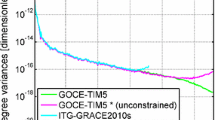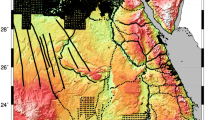Abstract
A synthetic [simulated] Earth gravity model (SEGM) of the geoid, gravity and topography has been constructed over Australia specifically for validating regional gravimetric geoid determination theories, techniques and computer software. This regional high-resolution (1-arc-min by 1-arc-min) Australian SEGM (AusSEGM) is a combined source and effect model. The long-wavelength effect part (up to and including spherical harmonic degree and order 360) is taken from an assumed errorless EGM96 global geopotential model. Using forward modelling via numerical Newtonian integration, the short-wavelength source part is computed from a high-resolution (3-arc-sec by 3-arc-sec) synthetic digital elevation model (SDEM), which is a fractal surface based on the GLOBE v1 DEM. All topographic masses are modelled with a constant mass-density of 2,670 kg/m3. Based on these input data, gravity values on the synthetic topography (on a grid and at arbitrarily distributed discrete points) and consistent geoidal heights at regular 1-arc-min geographical grid nodes have been computed. The precision of the synthetic gravity and geoid data (after a first iteration) is estimated to be better than 30 μ Gal and 3 mm, respectively, which reduces to 1 μ Gal and 1 mm after a second iteration. The second iteration accounts for the changes in the geoid due to the superposed synthetic topographic mass distribution. The first iteration of AusSEGM is compared with Australian gravity and GPS-levelling data to verify that it gives a realistic representation of the Earth’s gravity field. As a by-product of this comparison, AusSEGM gives further evidence of the north–south-trending error in the Australian Height Datum. The freely available AusSEGM-derived gravity and SDEM data, included as Electronic Supplementary Material (ESM) with this paper, can be used to compute a geoid model that, if correct, will agree to in 3 mm with the AusSEGM geoidal heights, thus offering independent verification of theories and numerical techniques used for regional geoid modelling.
Similar content being viewed by others
References
Adler RJ (1981) The geometry of random fields. Wiley, New York, 280 pp
Ågren J (2004). Regional geoid determination methods for the era of satellite gravimetry: numerical investigations using synthetic Earth gravity models, doctoral dissertation. Department of Infrastructure Royal Institute of Technology (KTH), Stockholm 246 pp
Claessens SJ (2003) A synthetic Earth model. Delft University Press, Delft, 61 pp
Dziewonski AM, Anderson DL (1981) Preliminary reference Earth model. Phys Earth Planetary Inter 25(4):297–356
Ellman A (2005). Two deterministic and three stochastic modifications of Stokes’s formula: a case study for the Baltic countries. J Geod 79(1–2):11–23 doi: 10.1007/s00190-005-0438-1
Featherstone WE (1999) Progress report for IAG SSG3.177 Synthetic modelling of the Earth’s gravity field. In: Anderson OB (ed) International association of geodesy, Travaux http://www.gfy.ku.dk/∼ iag/Travaux_99/ssg3177.htm
Featherstone WE (2002a). Prospects for the Australian height datum and geoid model. In: Adam J, Schwarz K-P (eds). Vistas for Geodesy in the New Millennium. Springer, Berlin Heidelberg New York, pp 96–101
Featherstone WE (2002b). Tests of two forms of Stokes’s integral using a synthetic gravity field based on spherical harmonics. In: Grafarend EW, Krumm FW, Schwarze VS (eds). Geodesy – The challenge for the Third Millennium. Springer, Berlin Heidelberg New York, pp 163–171
Featherstone WE (2004) Evidence of a north–south trend between AUSGeoid98 and the AHD in southwest Australia. Surv Rev 37(291):334–343
Featherstone WE, Olliver JG (1997) A method to validate gravimetric geoid computation software based on Stokes’s integral. J Geod 72(3):154–160 doi: 10.1007/s001900050125
Featherstone WE, Kirby JF, Kearsley AHW, Gilliland JR, Johnston GM, Steed J, Forsberg R, Sideris MG (2001) The AUSGeoid98 geoid model of Australia: data treatment, computations and comparisons with GPS-levelling data. J Geod 75(5–6):313–330 doi: 10.1007/s001900100177
Featherstone WE, Holmes SA, Kirby JF, Kuhn M (2004) Comparison of the remove-compute-restore and university of New Brunswick techniques to geoid determination over Australia, and the inclusion of Wiener-type filters in the reference field contribution. Journal of Surveying Engineering 130(1):40-47 DOI: 10.1061/(ASCE)0733-9453(2004)130:1(40)
Haagmans R (2000) A synthetic Earth model for use in geodesy. J Geod 74(7–8):503–511 doi: 10.1007/s001900000112
Hastings DA, Dunbar PK (1998) Development and assessment of the global land one-km base elevation digital elevation model (GLOBE). ISPRS Arch 32(4):218–221 http://www.ngdc.noaa.gov/mgg/topo/globe.html
Heiskanen WA, Moritz H (1967) Physical geodesy. WH Freeman and Co, San Francisco, 364 pp
Hilton RD, Featherstone WE, Berry PAM, Johnston CPD, Kirby JF (2003) Comparison of digital elevation models over Australia and external validation using ERS-1 satellite radar altimetry. Aust J Earth Sci 50(2):157–168 doi: 10.1046/j.1440-0952.2003.00982.x
Hutchinson M (2001) GeoData 9 second DEM version 2: a digital elevation model of Australia with a grid spacing of nine seconds in longitude and latitude. Data user guide, 2nd edn. Geoscience Australia, Canberra, Australia, 43 pp http://www.ga.gov.au/image_cache/ GA4783.pdf
Jekeli C (1988) The exact transformation between ellipsoidal and spherical harmonic expansions. manuscr geod 13(2):106–113
Kuhn M (2003) Geoid determination with density hypotheses from isostatic models and geological information. J Geod 77(1–2):50–65. doi: 10.1007/s00190-002-0297-y
Kuhn M, Seitz K (2005). Evaluation of Newton′s integral in space and frequency domain. In: Sansò F (eds). A Window on the Future of Geodesy. Springer, Berlin Heidelberg New York, pp 386–391
Kuhn M, WE Featherstone (2005). Construction of a synthetic Earth gravity model by forward gravity modelling. In: Sansò F (eds). A Window on the Future of Geodesy. Springer, Berlin Heidelberg New York, pp 350–355
Kuroishi Y, Ando H, Fukuda Y (2002) A new hybrid geoid model for Japan, GSIGEO2000. J Geod 76(8):428–436 doi: 10.1007/s00190-002-0266-5
Lemoine FG, Kenyon SC, Factor JK, Trimmer RG, Pavlis NK, Chinn DS, Cox CM, Klosko SM, Luthcke SB, Torrence MH, Wang YM, Williamson RG, Pavlis EC, Rapp RH, Olson TR (1998). The development of the joint NASA GSFC and the National Imagery and Mapping Agency (NIMA) geopotential model EGM96, NASA/TP-1998-206861, NASA/TP-1998-206861, Goddard Space Flight Center, National Aeronautics and Space Administration, Greenbelt
Moritz H (1980) Advanced physical geodesy. Herbert Wichman, Karlsruhe, 497 pp
Nahavandchi H, Sjöberg LE (2001) Precise geoid determination over Sweden using the Stokes-Helmert method and improved topographic corrections. J Geod 75(2–3):74–88 doi: 10.1007/s001900000154
Novák P, Vaníček P, Véronneau M, Holmes S, Featherstone WE (2001) On the accuracy of modified Stokes’s integration in high-frequency gravimetric geoid determination. J Geod 74(11):644–654 doi: 10.1007/s001900000126
Pail R (2000) Synthetic global gravity model for planetary bodies and applications in satellite gravity gradiometry. PhD Thesis, Technical University of Graz
Roelse A, Granger HW, Graham JW (1971) The adjustment of the Australian levelling survey 1970–1971. In: Technical Report 12, Division of National Mapping, Canberra, 81 pp
Rummel R, Rapp HR, Sünkel H (1988) Comparison of global topographic/isostatic models to the Earth’s observed gravity field, Rep 388, Deptartment Geodeic Science and Surveying Ohio State University, Columbus, 33 pp
Rummel R, van Gelderen M (1995) Meissl scheme – spectral characteristics of physical geodesy. manuscr geod 20(5):379– 385
Schwarz KP (1984). Data types and their spectral properties. In: Schwarz K-P (eds). Local gravity field approximation. Proc Int Summer School, Beijing, pp 1–66
Smith DA, Roman DR (2001) GEOID99 and G99SSS: 1-arc-min geoid models for the United States. J Geod 75(9–10):469–490 doi 10.1007/s001900100200
Tziavos IN (1996) Comparisons of spectral techniques for geoid computations over large regions. J Geod 70(6):357–373 doi: 10.1007/s001900050027
Vaníček P, Featherstone WE (1998) Performance of three types of Stokes’s kernel in the combined solution for the geoid. J Geod 72(12):684–697 doi: 10.1007/s001900050209
Vaníček P, Kleusberg A (1987) The Canadian geoid – Stokesian approach. manuscr geod 12(2):86–98
Vaníček P, Martinec Z (1994) Stokes-Helmert scheme for the evaluation of a precise geoid. manuscr geod 19(2):119–128
Author information
Authors and Affiliations
Corresponding author
Electronic supplementary material
The 13 files are unfortunately not in the Publisher's archive anymore.
Rights and permissions
About this article
Cite this article
Baran, I., Kuhn, M., Claessens, S.J. et al. A synthetic Earth Gravity Model Designed Specifically for Testing Regional Gravimetric Geoid Determination Algorithms. J Geodesy 80, 1–16 (2006). https://doi.org/10.1007/s00190-005-0002-z
Received:
Accepted:
Published:
Issue Date:
DOI: https://doi.org/10.1007/s00190-005-0002-z




